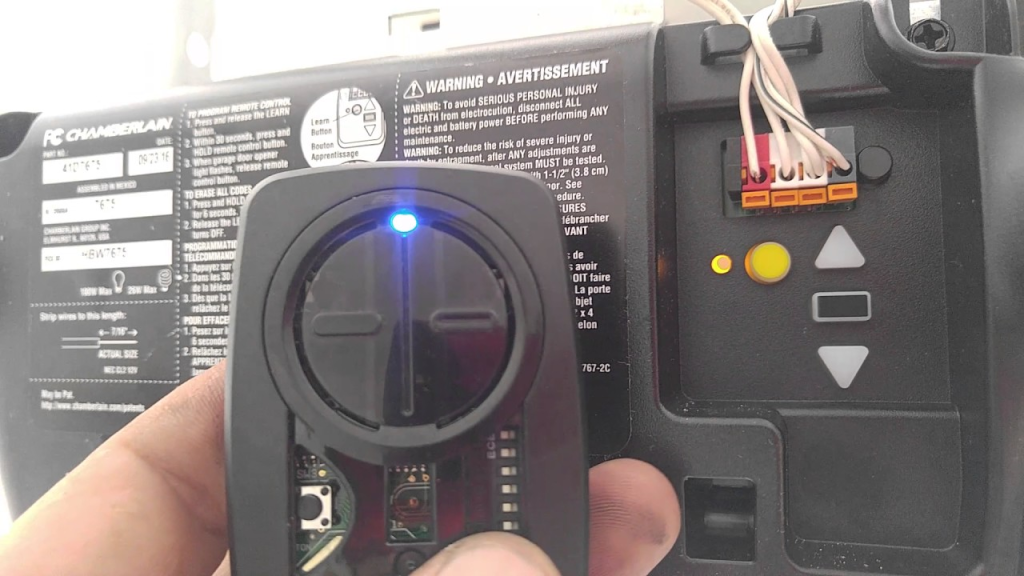Craftsman garage door openers are known for their reliability and ease of use. However, there are times when you may need to reprogram your Craftsman garage door opener—whether it’s to sync a new remote, reset the system after a power outage, or improve the security of your home. Understanding the process of reprogramming ensures that your garage door functions smoothly and securely.

This guide provides clear, step-by-step instructions to help you with the reprogramming process and tackles some common questions about Craftsman garage door openers. With this comprehensive resource, you can master the basics of reprogramming and troubleshooting your opener without needing professional help.
Why Reprogramming Your Craftsman Garage Door Opener Matters
Before we dive into the instructions, let’s explore why reprogramming your garage door opener might be necessary:
- Replacing or Adding a Remote Control: If you’ve lost or need to add a new remote control, reprogramming is essential to sync the new device with your opener.
- Power Outages or Electrical Surges: Sometimes, power outages or surges can disrupt your opener’s settings, making reprogramming necessary.
- Improved Security: Resetting your opener’s codes after moving into a new home or after an incident involving unauthorized access improves security.
Reprogramming your Craftsman garage door opener is an easy process, and following the right steps ensures that your garage remains safe and functional.
Read too: Craftsman 3/4 HP Garage Door Opener Parts List
Craftsman Garage Door Opener Reprogram: A Step-by-Step Guide
Step 1: Locate the “Learn” Button on the Opener
The first step in reprogramming your Craftsman garage door opener is to locate the “Learn” button on the main unit, typically mounted on the ceiling of your garage. The “Learn” button is usually found near the antenna wire and may be a specific color like yellow, red, green, or purple.
Each color corresponds to a different generation or model of Craftsman opener, so if you have the manual, it’s helpful to check which model you have. This button is essential for pairing your remote with the opener or resetting its programming.
Step 2: Clear the Opener’s Memory
If you’re reprogramming due to lost remotes or security concerns, start by clearing the opener’s memory. Clearing the memory deletes any previously programmed remotes, so only your new or existing remotes can access the opener.
- Press and Hold the “Learn” Button: Hold the “Learn” button for about 6-10 seconds until the indicator light turns off. This action clears the memory, deleting all previously programmed remotes.
- Wait a Few Seconds: Once the memory is cleared, wait for the light to turn off before proceeding to reprogram your remotes or keypad.
Step 3: Program the Remote Control
To program your remote control with your Craftsman garage door opener, follow these steps:
- Press the “Learn” Button Again: After clearing the memory, press the “Learn” button once more. The indicator light on the opener should begin to blink, indicating that it’s in programming mode.
- Press the Remote Button: Within 30 seconds, press and hold the button on your remote that you want to sync with the opener.
- Watch for the Indicator Light: When the opener’s indicator light stops blinking and stays solid, your remote has successfully paired with the opener.
- Test the Remote: Stand back and press the programmed button on your remote. If the door responds by opening or closing, the programming was successful.
If you need to program multiple remotes, repeat this process with each remote one at a time.
Step 4: Program the Keypad (If Applicable)
If your Craftsman garage door opener includes a wall-mounted keypad, follow these steps to program it:
- Press the “Learn” Button on the Opener: This will once again put the opener in programming mode.
- Enter Your Desired PIN on the Keypad: Within 30 seconds, go to the keypad and enter your desired 4-digit PIN, then press the “Enter” button.
- Wait for Confirmation: The indicator light on the opener will blink, confirming that the keypad is now programmed.
- Test the Keypad: Enter your PIN on the keypad and press “Enter.” The door should open or close, indicating that the keypad programming is complete.
Step 5: Test the System
Once you’ve programmed all remotes and the keypad, it’s essential to test the system to ensure everything is functioning properly. Walk outside and use each programmed remote to open and close the garage door. Test the keypad by entering the PIN and checking the door’s response.
If the door responds correctly each time, the reprogramming was successful.
Common Issues with Craftsman Garage Door Opener Reprogramming
Reprogramming should be straightforward, but sometimes issues can arise. Here are some common problems and troubleshooting tips:
Remote Isn’t Working After Programming
If your remote control isn’t working even after reprogramming, try the following:
- Check the Batteries: Ensure the remote has fresh batteries.
- Repeat the Process: Re-attempt the programming steps, ensuring you’re pressing the correct buttons in the right order.
- Clear the Memory Again: If you’re having trouble pairing multiple remotes, try clearing the memory again and start fresh.
The Keypad Isn’t Responding
If the keypad isn’t responding, double-check that you’ve entered the PIN correctly. If the keypad still doesn’t work:
- Replace the Batteries: Keypads often run on batteries, so replacing them can solve the issue.
- Verify Keypad Compatibility: Ensure that your keypad is compatible with your Craftsman garage door opener model.
- Repeat Programming Steps: Start the programming process again, being mindful of each step.
The Door Doesn’t Close Completely
If your door doesn’t close fully after reprogramming, this could be a sensor issue rather than a programming problem. Craftsman openers often have safety sensors that detect obstacles. Ensure that these sensors are aligned correctly and free of obstructions.
Maintenance Tips for Your Craftsman Garage Door Opener
To keep your garage door opener functioning smoothly after reprogramming, regular maintenance is essential. Here are some maintenance tips:
- Inspect the Opener and Tracks: Check the garage door opener, tracks, and rollers for any signs of wear or debris. Clean and lubricate them to keep the system operating smoothly.
- Test the Safety Sensors: Periodically check the safety sensors to ensure they are aligned and working correctly.
- Replace Batteries Regularly: Batteries in remotes and keypads can wear out over time. Replace them as needed to avoid connectivity issues.
- Tighten Hardware: Check the opener’s bolts, brackets, and other hardware to ensure they are tight and secure.
By following these maintenance steps, you can keep your Craftsman garage door opener in excellent condition and avoid frequent reprogramming needs.
Frequently Asked Questions (FAQs)
1. How often should I reprogram my Craftsman garage door opener?
You only need to reprogram your opener when adding new remotes, changing the keypad PIN, or after a security concern like a lost remote. Regular reprogramming is generally unnecessary.
2. Can I program multiple remotes with my Craftsman opener?
Yes, most Craftsman garage door openers can be programmed to work with multiple remotes. Simply repeat the reprogramming steps with each remote.
3. Will reprogramming affect the door sensors?
No, reprogramming your opener won’t affect the safety sensors. However, if the door doesn’t close properly, it’s worth checking the sensor alignment.
Final Thoughts on Craftsman Garage Door Opener Reprogramming
Reprogramming a Craftsman garage door opener is a straightforward process that homeowners can complete in a matter of minutes. Whether you’re adding a new remote, resetting the opener for security purposes, or adjusting the keypad, these steps will ensure your system functions correctly. By regularly maintaining your garage door opener and knowing how to reprogram it when necessary, you can enjoy seamless and secure access to your garage.
In addition to reprogramming, routine maintenance and troubleshooting minor issues keep your system reliable for years to come. So, if your opener ever malfunctions or you need to add a new remote, remember that a simple reprogramming process can save the day!





















